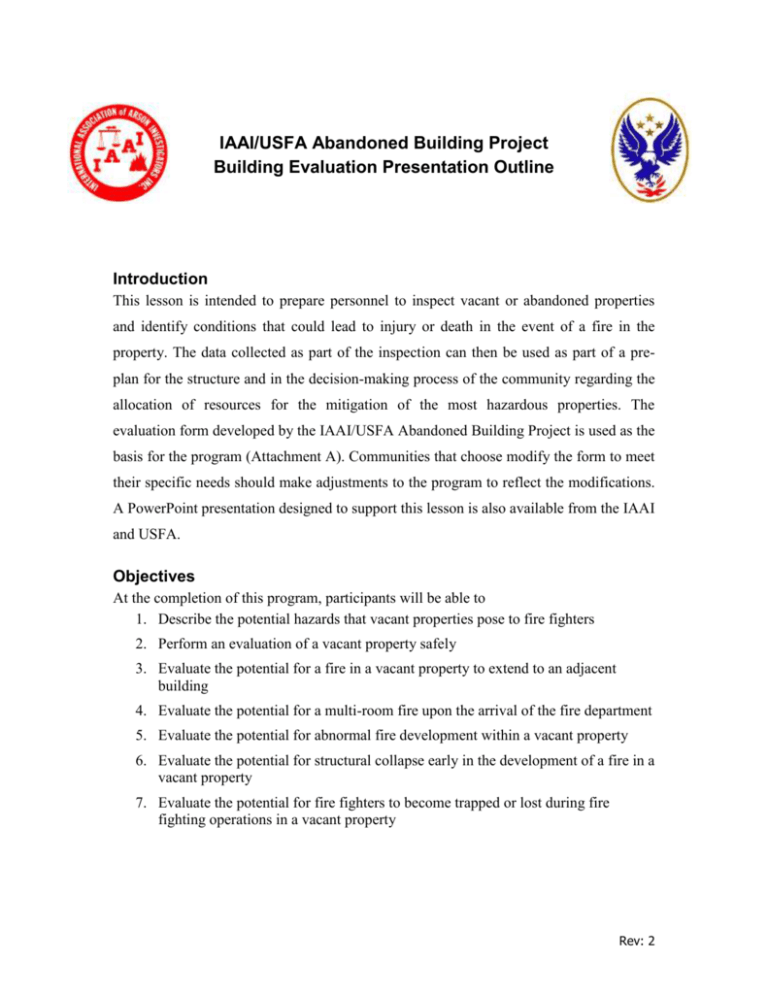Word - InterFire
advertisement

IAAI/USFA Abandoned Building Project Building Evaluation Presentation Outline Introduction This lesson is intended to prepare personnel to inspect vacant or abandoned properties and identify conditions that could lead to injury or death in the event of a fire in the property. The data collected as part of the inspection can then be used as part of a preplan for the structure and in the decision-making process of the community regarding the allocation of resources for the mitigation of the most hazardous properties. The evaluation form developed by the IAAI/USFA Abandoned Building Project is used as the basis for the program (Attachment A). Communities that choose modify the form to meet their specific needs should make adjustments to the program to reflect the modifications. A PowerPoint presentation designed to support this lesson is also available from the IAAI and USFA. Objectives At the completion of this program, participants will be able to 1. Describe the potential hazards that vacant properties pose to fire fighters 2. Perform an evaluation of a vacant property safely 3. Evaluate the potential for a fire in a vacant property to extend to an adjacent building 4. Evaluate the potential for a multi-room fire upon the arrival of the fire department 5. Evaluate the potential for abnormal fire development within a vacant property 6. Evaluate the potential for structural collapse early in the development of a fire in a vacant property 7. Evaluate the potential for fire fighters to become trapped or lost during fire fighting operations in a vacant property Rev: 2 LESSON PLAN – Evaluating Abandoned Buildings Lesson Plan Time Required: 2 Hours (4 with optional activity – Attachment B) Materials: Building Evaluation Form Support slides or slides of vacant/abandoned buildings in community References: Field Manual: Evaluating Vacant and Abandoned Properties, IAAI/USFA 2005 Building Construction for the Fire Service, Francis L. Brannigan Collapse of Burning Buildings, A Guide to Fireground Safety, Vincent Dunn Building Construction Related to the Fire Service, Second Edition, IFSTA Six Career Fire Fighters Killed in Cold-Storage and Warehouse Building FireMassachusetts, NIOSH Investigative Report #99F-47, September 2000 Overview: Introduction – Why evaluate vacant buildings? Safety during the evaluation process Building security and marking Evaluating Building Construction Evaluating the Contents Evaluating the Fire Potential Evaluating Exposures Identifying Hazards to Suppression Operations Methodology Lecture/discussion Optional field activity Rev: 2 LESSON PLAN – Evaluating Abandoned Buildings Program Outline I. Introduction – Why evaluate vacant buildings? A. Vacant or abandoned – What is the difference? – Discuss the difference between a vacant and an abandoned property and the importance of early intervention in the vacancy progression to deal with the properties while a viable property owner is still available. B. The magnitude of the problem – Discuss the statistics provided in the background section above regarding the magnitude of the problem in our cities and towns. Review the issues and statistics in your community. C. Do you have the authority to inspect a vacant property? – Discuss the codes and ordinances that provide the authority to inspect properties the jurisdiction and the process that must be followed. II. Safety During the Evaluation A. Potential hazards in vacant or abandoned properties 1. Unstable structure 2. Fall and trip hazards 3. Standing water in basements 4. Vermin 5. Hazardous materials on property 6. Unauthorized occupants 7. Potential for criminal activity on property B. Personal protective clothing and equipment 1. Hard hat 2. Gloves 3. Safety shoes or boots 4. Flashlight 5. Radio III. Building Security and Marking A. Why is security important B. What methods can be used to properly secure vacant or abandoned properties – Discuss the requirements of the jurisdiction C. Marking vacant and abandoned properties – Discuss the marking system used by the jurisdiction Rev: 2 LESSON PLAN – Evaluating Abandoned Buildings IV. Evaluating the Building A. The Objectives of a building evaluation 1. Determine if the building is secure 2. Identify hazards that require immediate corrective action 3. Evaluate the fire growth potential a. Potential for exposure fires b. Identify available fuel packages c. Identify fire barriers that have been compromised d. Identify the location and type of hazardous materials on the site 4. Evaluate the potential for structural collapse 5. Identify conditions that will be hazards to fire fighters in the event of a fire B. Property Data 1. Owner information 2. Is the building secure? – Evaluating the security of the building and determining if there are signs of recent entry 3. Does the building have active utilities? 4. What was the original use of building and has it been modified for other uses? C. Building Construction 1. Number of floors and basements 2. Structural members 3. Truss construction – Roof or floors 4. Exposed structural members – Are they exposed as part of the construction or as a result of damage to the property? 5. Construction of the exterior walls – Are metal tie rods (stars) used as part of the system? 6. Number and size of openings in the exterior walls – Discuss the implications of openings to timely discovery of the fire and the potential for exposure fires. 7. Ceiling – Discuss the hazards of different ceiling configurations and the impact on fire development that the removal of the ceiling system could have. D. Evaluating the condition of the structure 1. What is the condition of the interior walls –Discuss how penetrations can allow fire spread from compartment to compartment also impact the integrity of the structure. 2. What is the condition of the roof – Discuss the implications of a deteriorated roof for early collapse and risks involved for fire fighting operations. 3. What is the overall condition of the structure – Discuss the indicators of early collapse in unstable buildings. Rev: 2 LESSON PLAN – Evaluating Abandoned Buildings E. Fire Protection Systems 1. Is there an operational fire alarm system – Discuss the importance of keeping detection and alarm systems operational if possible 2. Are there operational sprinkler or standpipe systems in the building 3. Does the condition of suppression systems to allow them to be used if supplied by the fire department connection V. Fire Potential A. Fuel Packages 1. What is a fuel package 2. The impact of the quantity and arrangement of fuel packages on fire growth 3. The impact of interior finish on fire development 4. Housekeeping B. The configuration of the buildings interior and fire development 1. Large rooms 2. Medium size rooms 3. Small rooms 4. Interior configurations that could lead to fire fighters becoming lost under fire conditions C. Potential for delay in fire department notification 1. Windowless building 2. Vacant properties surrounding property being evaluated 3. Remote location VI. The Potential for Exposure Fires A. Potential exposures 1. Location 2. Separation 3. Occupied or vacant VII. Suppression Operations in Vacant or Abandoned Structures A. Hazards in the building 1. Holes in floors 2. Missing stairs 3. Open shafts or pits 4. Potential for disorientation under fire conditions B. Fire Development 1. Rapid unexpected fire development 2. Early collapse C. Impediments to fire fighting operations 1. Delay in alarm 2. Lack of access 3. Poor water supply Rev: 2 LESSON PLAN – Evaluating Abandoned Buildings VIII. Hazardous materials located on the site A. Type B. Quantity IX. Conditions that Require Immediate Correction A. Security B. Accumulations of trash or other fuels C. Significant hazards to public safety X. Analysis of findings A. B. C. D. Exposure potential Potential for multi-room fire on arrival Potential for early structural collapse Hazards to fire fighting operations XI. How is the Information Used A. B. C. D. Marking the building Initiating the correction of hazardous conditions Pre-Fire Planning Allocation of mitigation resources The instructor can find support information in the Background Information package provided with this program. Rev: 2 Attachment A – Vacant/Abandoned Building Evaluation Form Rev: 2 Rev: 2 Rev: 2 Attachment B – Evaluation Activity LESSON PLAN – Evaluating Abandoned Buildings Building Evaluation Activity This activity is provided as an optional element of the IAAI/USFA Vacant/Abandoned Building Evaluation program. It is intended to provide participants with hands on experience in evaluating vacant or abandoned structures using the IAAI/USFA Evaluation form. Materials and Equipment Personal protective clothing Flashlight Radio Evaluation forms Graph/grid paper Pen or pencil Ruler Preparation and Safety Locate a vacant or abandoned building that is available for the activity. Permission from the owner should be obtained prior to entry. The lead instructor should inspect each property prior to assigning teams to a building. Buildings with significant hazards should NOT be used for this activity. An instructor equipped with a portable radio should act as safety officer while participants are operating in the building. Activity Divide the group into teams of 2 to 4 participants. Assign two or more teams to each of the properties identified for the activity. Teams should be instructed to conduct an evaluation of the structure independently. Each team should complete the evaluation form and develop a sketch of the assigned building. Teams assigned to each building should present their findings to the group individually. Any variations in evaluations of the building should be discussed in detail and a consensus achieved. Continue with reports until all assigned buildings have been discussed. IAAI/USFA Abandoned Building Project 11 Rev: 2 LESSON PLAN – Evaluating Abandoned Buildings Using the PowerPoint Support Slides The PowerPoint support slides provided with this lesson plan are intended to provide a graphical element to this presentation. While the talk can be delivered without the slides, seeing examples of what is being discussed will make a lasting impression on the audience. The PowerPoint file can be projected using a computer and projector or the slides can be printed as transparencies. The presenter can use the features provided with PowerPoint to provide handouts to the participants by printing the Handout view from the file. Presenters should also review the Notes view of the file as additional information regarding most of the slides is provided. For those with the capability, photos of buildings and issues from the local community can be easily added to the program to customize the program. IAAI/USFA Abandoned Building Project 12 Rev: 2









